|
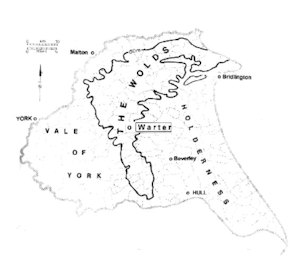 The Estate Village of Warter The Estate Village of Warter
Warter is a small village on the Yorkshire Wolds. It is situated some 16 miles (26 km.) from York and 24 miles (39 km.) from Hull. For nearly three hundred years Warter has been the property of a single owner and until 1969 the owners were resident in the parish for at least part of the year.
As with all villages Warter has undergone great changes since the end of the Victorian period.
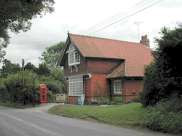
|
Warter Post Office |
- It is much smaller: In 1901 Warter had a population of 559 but now fewer than 200 people live in the parish.
- It has far fewer shops and tradesmen: Today there is just one shop in Warter. One hundred years ago a trade directory and census returns record three general shops, two shoemaker's shops, a tailor's shop, a saddler's shop, and the workshops of two blacksmiths, two wheelwrights and a carpenter.
- It no longer has a place of worship: A hundred years ago it had three - an Anglican church, a Wesleyan Methodist chapel and a Primitive Methodist chapel.
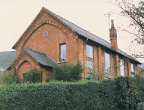
|
The former Wesleyan Methodist Chapel, now a private house. |
- Jobs have changed: Although Warter is still a farming settlement, the majority of the residents no longer work on the land as they did until less than fifty years ago.
- The village looks much as it did 100 years ago: Only a handful of the present village houses were built after 1900, and with the well-kept hedges and gardens it is still one of the prettiest villages in Yorkshire, attracting visitors as it did in the late Victorian period.

1900
|

2000

|
List the differences you can spot between the two pictures of Warter reproduced above. |
|
- It still has a village school: Now held in one of the few buildings erected in Warter in the late 20th century, the thriving school has 50 per cent more pupils than it did 100 years ago.
- All the land and almost all the houses still belong to one landowner: Unlike a hundred years ago the landowner does not live in the parish.
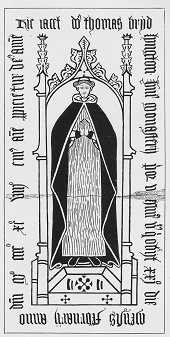 |
Gravestone of a Prior of Warter discovered when the priory site was excavated in 1899 |
How did the whole village become the property of one landowner?
-
The estate had its origins in the Middle Ages when the greater part of Warter was owned by the monks of Warter Priory, an Augustinian monastery that was established in 1132. The village church stands on the site of the priory church and in the field to the north can be seen the earthworks of the other monastic buildings. When Henry VIII closed down the Priory in 1536, its buildings and land were acquired by the Duke of Rutland.
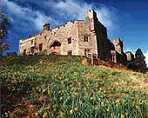
|
Muncaster Castle |
From around 1630 the Warter estate was owned by the Stapleton family from whom it passed by marriage in the late 17th century to Sir William Pennington of Muncaster Castle
[www. muncastercastle.co.uk] in Cumberland.
- At first the Penningtons did not own the whole village but during the earlier 18th century they purchased all the other freehold land in Warter. They then reduced the number of village houses by a third.
By 1787 the Penningtons owned everything except two small plots of land and the church and churchyard.
- The Penningtons lived part of the year at Muncaster Castle, part in London and part at Warter Hall, known as Warter Priory by 1840, a house they built a mile from the village. Sir John Pennington, baronet, a friend of William Wilberforce, was created 1st Lord Muncaster in 1783.
The Victorian and Edwardian owners of Warter
The Penningtons, Lords Muncaster
- The 3rd Lord Muncaster, who died at Warter in 1838, was succeeded by his six-year old son, Gamel Augustus, 4th Lord Muncaster. His mother Lady Muncaster ruled the estate until he came of age at the end of 1852.
- The 4th Lord Muncaster, who began the reconstruction of Warter village, died of a fever in Southern Italy in 1862. He was succeeded as 5th and last Lord Muncaster by his brother Josslyn Francis Pennington (1834-1917), who enlarged Warter Priory, built the church and school and continued the rebuilding of the village. In 1870 he was captured, with his wife and others, by Greek brigands. Four of the party, but not the Muncasters, were put to death before the ransom arrived. This incident is said to have contributed to Lord Muncaster's decision to sell the Warter estate in 1878. The estate was bought by Charles Wilson, a Hull shipowner and MP.
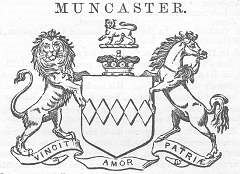
|
The Coat of Arms of the Lords Muncaster. The shield should be coloured gold and the diamonds coloured blue. |
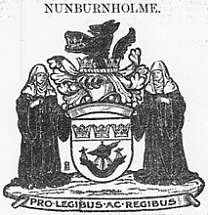
|
The Coat of Arms of Lord Nunburnholme. The boat should be black with a gold background. The three ducal coronets are coloured gold with a blue background. |

|
Why do you think there is a boat on the arms of Lord Nunburnholme? |

|
Why is the shield flanked by two nuns? |

|
Find out about heraldry and design your own coat of arms. |
The Wilsons, Lords Nunburnholme
 Charles Henry Wilson, was born in 1833, the eighth son of Thomas Wilson, the founder of a Hull shipping firm. As well as becoming head of what became, by his death, the largest private shipping line in the world, he was director of the Hull Dock Company and of the North Eastern Railway Company. He was chosen as Sheriff of Hull in 1870. In 1874 he became Liberal MP for Hull, transferring to West Hull in 1885 when the borough was split into three constituencies. Charles Henry Wilson, was born in 1833, the eighth son of Thomas Wilson, the founder of a Hull shipping firm. As well as becoming head of what became, by his death, the largest private shipping line in the world, he was director of the Hull Dock Company and of the North Eastern Railway Company. He was chosen as Sheriff of Hull in 1870. In 1874 he became Liberal MP for Hull, transferring to West Hull in 1885 when the borough was split into three constituencies.
A great philanthropist during his lifetime he was generous to many charitable causes and in particular hospitals and orphanages in Hull as well as numerous charities associated with care of the bereaved families of sailors and fishermen. Charles Wilson remained an MP until 1906 when he was created 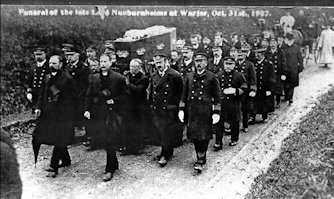 1st Baron Nunburnholme and entered the House of Lords. George Noble, who began work on the estate in 1908 recalled that: 'There was rumours all over Warter that they were going to call him Lord Warter, Lord Highcliffe, because they had a big wood called Highcliffe, then it came out Nunburnholme. Well, they had a lot of property in Nunburnholme, they owned about nearly half of Nunburnholme.' Lord Warter might have been appropriate for the head of a shipping line. 1st Baron Nunburnholme and entered the House of Lords. George Noble, who began work on the estate in 1908 recalled that: 'There was rumours all over Warter that they were going to call him Lord Warter, Lord Highcliffe, because they had a big wood called Highcliffe, then it came out Nunburnholme. Well, they had a lot of property in Nunburnholme, they owned about nearly half of Nunburnholme.' Lord Warter might have been appropriate for the head of a shipping line.
Little more than a year later Lord Nunburnholme died and his funeral on 31 October 1907 was probably the largest and most impressive event to occur in the history of Warter.

|
Who are the men in uniform accompanying the coffin? |

|
What was the weather like on the day of the funeral? |
Lord Nunburnholme was succeeded by his eldest son, Charles Henry Wellesley Wilson (1875-1924), who became 2nd Baron Nunburnholme; however Warter Priory remained the home of his mother, the Dowager Lady Nunburnholme, for another 20 years.
The Formidable Lady Nunburnholme
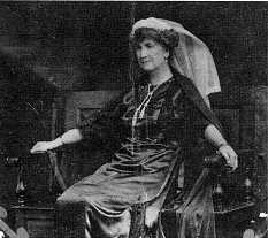 From the purchase of the Warter Estate by her husband in 1878 until its sale over 50 years later, the village of Warter and the lives of the villagers were dominated by Lady Nunburnholme. From the purchase of the Warter Estate by her husband in 1878 until its sale over 50 years later, the village of Warter and the lives of the villagers were dominated by Lady Nunburnholme.
Born in London in 1854 Florence Jane Helen Wellesley was the eldest daughter of Colonel William Henry Charles Wellesley, a nephew of the great Duke of Wellington. She married Charles Wilson in 1871 and they lived at Cottingham, near Hull before moving to Warter Priory in 1878.
George Noble had many stories of Lady Nunburnholme: She was a Wellesley, the Duke of Wellington's family. Warter Priory was full of Duke of Wellington's busts and oil paintings. She used to say "I've got the blood and Mr Wilson has the money." Which he had. … By jove she was a rum un, I'll tell you that, yes, but when she was alright, she was alright, but by jove she was a goer on as we say… She liked entertaining and she was the boss, and it was no good anybody what worked there telling her off, for she would get his notice just after, you know, pack-up … she would nearly clear him off the place straightaway and pay him up… The butler used to say to me dad, and he was there a long time, and knew 'em all. "Bill", he used to say "Devil's abroad, she's on the warpath … she's playing devil with me and everybody else she's come across - if you can find another job, getaway, out of road."

|
Look at the photograph of Lady Nunburnholme above. Do you think you would have wanted to live in Warter when she ruled the estate? A little later' you will be asked to give reasons for or against living in an estate village one hundred years ago. |

|
This is a photograph of George Noble (born 1894) whose memories of Lady Nunburnholme were recorded when he was 85. What year was that? |
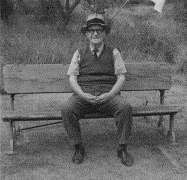
|
The Dowager Lady Nunburnholme died in 1932. The Warter estate had by then been sold by her grandson Charles John, 3rd Baron Nunburnholme. It was bought in 1929 by George Vestey who made Warter Priory his home until his death in 1968. Warter was then sold to the 4th Marquis of Normanby and the Guiness Trust. In turn the 5th Marquis of Normanby sold the Warter estate covering 11,910 acres (4,820 hectares) with 63 houses and cottages to a Hull-born businessman Malcolm Healey in 1998, echoing the sale to Charles Wilson of Hull 120 years before.
Homes and households
The mansion of the landowner dominated the life of the estate village that stood at its gate. The village was ruled from the house which with its gardens, parkland, woodland and shoots provided employment for a high proportion of the population. In the late 19th century such country houses reached a peak in size and lavish living.
The village was an extension of the great house and park for it was the intention of most landowners to provide a picturesque setting for his or her home that would demonstrate to the visitor good taste and a concern for the well-being of the estate workers. The village houses were probably architect-designed with a uniformity of style and a range of decorative details. They would be larger than the usual labourers' cottages and almost certainly set back in a sizeable garden.
A. Warter Priory - The big house at Baggaby Bottom

|
Air view of the house, garden and parkland shortly before the house was
demolished in 1972 |
The Muncasters and the Wilsons lived in a grand style at Warter Priory, the 'big house' that stood in a 400 acre (162 hectare) park almost a mile (1.5 km.) from the village to the south of the road to Pocklington. (see map 2) The land to the north of the house was called Baggaby Bottom.
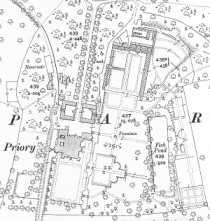
|
Warter Priory and pleasure gardens in 1910 25" OS Plan (reduced). |
Originally a modest late 17th- century country house Warter Priory was enlarged many times. The major Victorian extensions were in 1872, when it was re-fronted and corner towers added, and in 1885 when a tall entrance tower and a great hall were added.
Homes and households

|
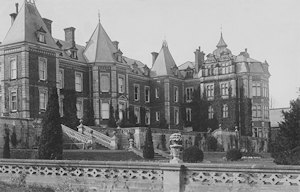
|
A drawing of the south front of Warter Priory in 1720. (British Library) |
The south front of
Warter Priory around 1910 |

|
Can you see the shape of the 1720s house in the view of the south front in 1910? |

|
What additions were made in the Victorian period? |
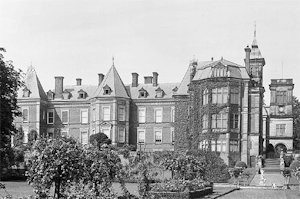 In the 1880s Charles Wilson added greatly to the north front. In this photograph of the east front the 1880s additions are at the right-hand side. In the 1880s Charles Wilson added greatly to the north front. In this photograph of the east front the 1880s additions are at the right-hand side.
Can you see the different style of windows and roof of the addition?
Warter Priory in 1901
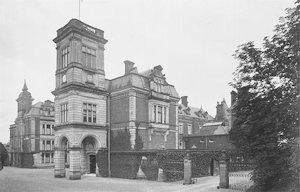 A visitor to Warter Priory a hundred years ago would arrive by horse-drawn coach or possibly in a motor car and stop in the arched entrance way below the recently built three-storey tower. This was to ensure that the visitor would not get wet when stepping from the coach or new-fangled automobile. A visitor to Warter Priory a hundred years ago would arrive by horse-drawn coach or possibly in a motor car and stop in the arched entrance way below the recently built three-storey tower. This was to ensure that the visitor would not get wet when stepping from the coach or new-fangled automobile.
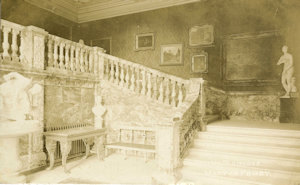 Once inside the visitor would be led up the very grand marble staircase, lined with statues and pictures, to the Great Hall or 'Saloon'. Once inside the visitor would be led up the very grand marble staircase, lined with statues and pictures, to the Great Hall or 'Saloon'.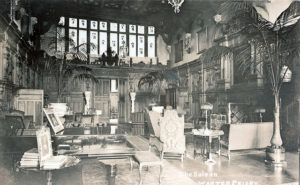
The Saloon, which was modelled on the Great Hall of a medieval castle, is shown here as a sitting room full of furniture and potted plants.
What should it have looked like?
Few other pictures survive of the interior of Warter Priory but we know that the house had over 90 rooms. The house was more like a hotel than a family home. When the house was sold in the 1920s the sale catalogue listed 38 bedrooms and 16 bathrooms. On the next page we will tell you a little about them.
The main entertaining rooms were:
- The Great Hall which measured 63ft by 30ft. It was oak panelled in the 'Tudor manner' and had 'a lofty raftered ceiling resting on carved stone corbels'.
- The Green Drawing Room which measured 36ft by 20ft.
- The Red Drawing Room. A T-shaped room measuring 38ft by 19ft and 31.5ft by 22.5ft. The room was hung with red silk damask and had 'enriched plaster ceilings' with painted panels.
- The Dining Room which measured 60ft by 30ft. The fireplace had an Italian marble and alabaster surround carved with dragons and cupids and floral and fruit designs.
- The Smoking Room which measured 22ft by 20.5 ft. It had French windows opening to stone steps to the Terrace.
- The Old Smoking Room which measured 22ft by 20ft.
- The Billiard Room which measured 33ft by 16ft.

|
The measurement of the rooms given above are in feet. Convert these to metres and centimetres. (1 ft. = 0.305 metres.) |

|
Now compare the size of the main rooms at Warter Priory with the size of your classroom and rooms at your home. |
Amongst the rooms in The Family Wing were a Large Schoolroom on the ground floor with a Night Nursery adjoining, and Lady Nunburnholme's Sitting Room and Bedroom both of which measured 31ft by 28ft. The Principal Guests' Bed Chambers included the Genoese Room, the Italian Room, the Queen Anne Room, the Bird Room, the Black Room, the Blue Room, the Green Room and The French Suite and a Lady's Maid's Room. The unmarried male visitors were accommodated in The Bachelors' Wing where there were four bedrooms and two valets' rooms each with space for three beds. At the top of the house was the accommodation for the servants which included a housekeeper's bedroom, four bedrooms for resident housemaids, five bedrooms for visiting maids, three bedrooms for footmen and two valets' rooms.
The Domestic Offices or Service Rooms were on the ground floor and included:
- Large Kitchen
- Scullery
- Larder
- Butchery
- Egg Larder
- China Pantry
- Still Room
- Butler's Pantry with Plate Safe
- Butler's Office
- Housekeeper's Room, fitted with a large range of cupboards
- Housemaids' Sitting Room
- Knife and Boot Cleaning Rooms
Below were the extensive cellars.

|
How many rooms are there in your home? |

|
What are they used for? |

|
How many people live in your house? |

|
How many lived at Warter Priory in the late 19th century? |
The answer to the question How many lived at Warter Priory in the late 19th century? can be found in Census Returns. In 1801 and every ten years since, except 1941, a national census has been taken. The full details are available for the seven censuses 1841-1901 and the original forms filled in by the local enumerator can be looked at on microfilm in your local studies library or archives office.
Victorian landed families spent much tome away from home, on weekend or longer visits to other grand families, or in London, Scotland or at resort towns in Britain or in mainland Europe. On census night in 1881 Charles Wilson was at Warter Priory alone with the housekeeper and six maids for company. The whole family were away from the Priory on census night in 1901 and only a valet, six maids and a hall boy were resident. Fortunately when the census was taken in 1891 there was a full household present.
The household at Warter Priory on 6 April 1891
Key to headings of columns in transcription: 1 - Relation to Head of Family 2 - Condition as to Marriage. 3 and 4 Age last Birthday of Males (3) and Females (4) 5 - Employer, Worker or Own Account The place of birth in last column is in the East Riding of Yorkshire unless stated. Click here for a PDF version of these statistics which you can print out and use to answer the questions below.
Name/Surname |
1 |
2 |
3
M |
4
F |
Occupation |
Where born |
Charles Henry Wilson |
Head |
married |
57 |
|
Steam Ship Owner & MP, JP, DL. |
Hull |
Florence J H Wilson |
wife |
married |
|
37 |
|
India British Subject |
Charles H.W. Wilson |
son |
single |
16 |
|
|
Cottingham |
Guy G Wilson |
son |
single |
13 |
|
|
London |
Enid Edith Wilson |
daughter |
single |
|
12 |
|
Marske, Yorks |
Joan E J Wilson |
daur |
single |
|
11 |
|
Warter |
Gwladys A.G. Wilson |
daur |
single |
|
9 |
|
London |
Gerald V. Wilson |
son |
single |
6 |
|
|
London |
Catherine H. Malet |
visitor |
single |
|
64 |
|
Cork, Ireland |
Herbert A. Wellesley |
visitor |
single |
38 |
|
Stockbroker |
Forton, Hants |
Bertha A.E.A. Schultz |
governess |
single |
|
28 |
Governess |
Naisse, Prussia |
William Morris |
servant |
single |
30 |
|
Butler |
Lantwerdine, Wales |
George Thomas |
servant |
married |
23 |
|
Cook |
France |
Edward Joachim |
servant |
single |
27 |
|
Cook |
France |
Herbert W. Jarratt |
servant |
single |
26 |
|
Under Butler |
London |
Frank Rokes |
servant |
single |
26 |
|
Footman |
London |
Percy J Torrince |
servant |
single |
26 |
|
Footman |
Peckham, London |
Samuel Butterfield |
servant |
single |
22 |
|
Stewards Room Boy |
London |
Mary Ann Wood |
servant |
single |
|
49 |
Housekeeper |
Sevenoaks, Kent |
Catherine Vanden |
servant |
single |
|
47 |
Ladies Maid |
The Hague, Holland |
Mary A Thompson |
servant |
single |
|
26 |
Nurse |
London |
Jessie E Atkinson |
servant |
single |
|
21 |
Stillroom maid |
Beverley |
Amy W Weldoset |
servant |
single |
|
21 |
Schoolroom maid |
Willington, Derbys |
Margaret M Ostom |
servant |
single |
|
30 |
Scullery maid |
Chevelly, Suffolk |
Mary Fahey |
servant |
single |
|
36 |
Laundry maid |
Newcastle, Northumbld |
Ann Payner |
servant |
single |
|
31 |
Laundry maid |
Wyrley, Staffordshire |
Eliza Shaw |
servant |
single |
|
28 |
Laundry maid |
Horn, Yorks |
Eliza Armstrong |
servant |
single |
|
20 |
Laundry maid |
Stirling, Scotland |
Ada Chapman |
servant |
single |
|
22 |
Housemaid |
Kendal, Westmorland |
Ada Atchison |
servant |
single |
|
23 |
Housemaid |
Howick, Northumbld |
Lucy Laxton |
servant |
single |
|
20 |
Housemaid |
Rugby, Leicestershire |
Jame Farmer |
servant |
single |
|
17 |
Housemaid |
Grimsby, Lincolnshire |
Eudunie Pele |
servant |
single |
|
19 |
Nurserymaid |
Dinard, France |
Rosa Gibbs |
servant |
single |
|
21 |
Kitchenmaid |
Maperton, Somerset. |

|
How many are there in the Wilson family? |

|
There are two visitors; one we know is related to Mrs Wilson. Which one? |

|
How many servants are there in the house? What are the duties of the servants? |

|
Where were the people listed born? List all the counties and countries and find them in an atlas. Then find out where everyone in the class and your teacher was born. |
The demolition of Warter Priory

|
Newspaper headlines in 1972 |
The house and gardens at Warter Priory were maintained much as they had been in Lady Nunburnholme's time right up to the death of the Hon. George Vestey in 1968. The estate was sold to the Guinness Family Trust in December 1968. The contents of the house were auctioned in March 1969, and the garden statuary the following September.
The new owners had large houses elsewhere and did not want to live at Warter Priory. Attempts were made to find a tenant for the house but when no suitable use could be found it was decided to demolish the house.
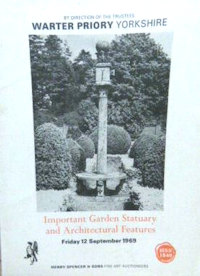
|
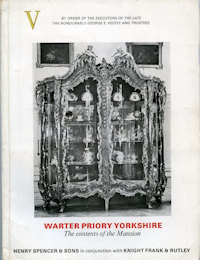
|
Sale catalogues, 1969 and 1972 |
All the remaining fittings of the house, from floorboards to toilet seats, were sold in May 1972. Shortly afterwards the great house was demolished, the splendid gardens bulldozed, and the rubble used to fill the nearby lake. Farm buildings were then erected on the site.
Few voices were raised in defence of this impressive but unmanageable house that was considered by many a Victorian monstrosity. Warter Priory was only one of over 1,000 English country houses demolished in the twentieth century.

|
Do you think Warter Priory should have been saved? |

|
Give reasons for and against saving the building. |

|
How would you have campaigned to save the building? |

|
What could the building have been used for? |
Village housing
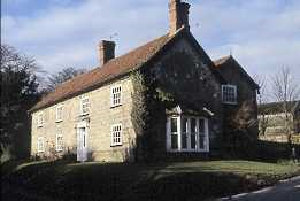 At the beginning of the Victorian period the houses of Warter village were probably little better than they had been a century before when the estate steward had written that 'a great many of the houses are very mean and much of the wood decayed'. The houses were seemingly constructed of mud, timber and thatch. The steward recommended that the houses should be built in brick. One of farmhouses that was rebuilt at this time is Manor Farm. The estate records show that it was rebuilt 1731-2 using bricks but it was fronted with dressed stone which almost certainly came from the site of the medieval priory. At the beginning of the Victorian period the houses of Warter village were probably little better than they had been a century before when the estate steward had written that 'a great many of the houses are very mean and much of the wood decayed'. The houses were seemingly constructed of mud, timber and thatch. The steward recommended that the houses should be built in brick. One of farmhouses that was rebuilt at this time is Manor Farm. The estate records show that it was rebuilt 1731-2 using bricks but it was fronted with dressed stone which almost certainly came from the site of the medieval priory.
The farms may have been rebuilt in the 18th century but not the cottages for in 1865 Dr H.J. Hunter noted in his 'Inquiry on the State of the Dwellings of Rural Labourers' that:
Warter is an extraordinarily shabby village, but the population is far from being wretched. They have to put up with mossy, mouldy thatch, with bulging walls, uneven floors, windows that will not open and doors that will not shut. They have to sleep in windowless, chimneyless lofts; but even the worst of these hovels is highly valued, and highly paid for.
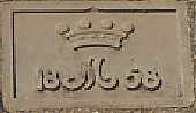 These comments which appeared in print in the Report of the Medical Officer of the Privy Council seem to have shamed Lord Muncaster into further action. He had already begun to rebuild the village houses; the picturesque red brick cottage between the pond and the church, originally two cottages, has an initial M picked out in blue brick and the date 1858. The same date, with an initial M and coronet, is on a pair of cottages some distance to the west of the village. These comments which appeared in print in the Report of the Medical Officer of the Privy Council seem to have shamed Lord Muncaster into further action. He had already begun to rebuild the village houses; the picturesque red brick cottage between the pond and the church, originally two cottages, has an initial M picked out in blue brick and the date 1858. The same date, with an initial M and coronet, is on a pair of cottages some distance to the west of the village.
It was from the late 1860s that the reconstruction of the village really began. A new school and school house were built in 1868, then the pair of red brick cottages opposite were built in 1871 (Timbertops), and nos. 1-3 Nunburnholme Road in 1874. These and other houses in and around the village have features typical of Victorian buildings.
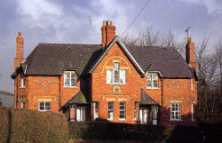
|
Timbertops |
- Red Brick
- Cream and dark blue brick decorative details
- Roofs of Welsh slate imported via the railways
- Gabled and hipped roofs
- Timber porches
- Decorative ironwork
- Casement windows
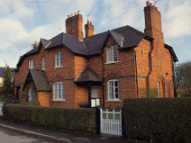
|
1-3 Nunburnhome Road |
Charles Wilson continued with cottage building after he bought the Warter estate in 1878. He employed Hull's leading architectural firm, Smith and Brodrick, who were responsible for a change in the style of the village housing. Some of the pairs of cottages they built along Nunburnholme Road were quite plain but Ornamental Cottages, a row of three built to the west of the village in 1880, are very showy. The row is pretending to be a late medieval farmhouse from south-east England. It has a red brick ground floor but the first floor and gable to the left is timber-framed, and the gable to the right is tile-hung.
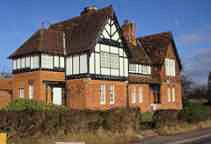
|
Ornamental Cottages |
Each of the three cottages in the row contained a sitting room, kitchen, scullery, dairy, three bed rooms, outside coal house, tool house and an earth closet. The cottages were supplied with spring water carried from a reservoir.
The occupants of number 2 Ornamental Cottages recorded in the1901 census were:
- William Noble, aged 37, the estate plumber and glazier and his wife Elizabeth, aged 34.
- Their five children - James, aged 12, Agnes, aged 11, Hilda, aged 9, George, aged 6 and Lily, aged 4.
- A lodger, Frederick Comley, aged 24, who was a butler, working at Warter Priory
Some of George Noble's reminiscences, recorded in 1979, are used in this module of the History Footsteps.
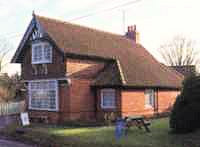
|
The village shop built to replace the Creeping Kate Inn which was closed in 1882. This picturesque building has a tile-hung first floor with an oriel window in the gable with half timbering above. |
By 1901 almost all the cottages in the village were new built in brick and slate. Out of some 40 cottages more than half had three or more bedrooms, as well as a living room and kitchen.
The cottage accommodation was greatly improved, both in quality and scale, compared with half a century before. But this was not so in every local village. The following description of a house at the brickyards at Seaton Ross in 1905 provides a contrast:
The house, occupied by Henry and Margaret Wilson and their four children aged 5 to 16, was a one-storeyed building, with two rooms on the ground floor. In the living room there was no furniture except a kettle, dripping tin, two tin mugs and a bowl on the washstand. There was no knife, fork or spoon in the place. In the kitchen there were some drain pipes, on which were planks and sacking filled with straw, which Mrs Wilson described as her husband's bed. There was no bed clothing whatever. There was a similar bed for the children, but neither fire nor food in the place.
Pocklington Weekly News 17 November 1905
Not all the cottages in Warter had been rebuilt by the early 20th century. In the centre of the village was Barrack Row, a terrace of six one-bedroomed cottages built of brick and chalk with pantiled roofs. George Noble remembered them as being for elderly people .. 'and do you know, inside there was only one living room, very small, and they had a stepladder to go to bed, through the manhole [trapdoor], you know, then there was a beam across the top, and if they were in bed and got up they almost could catch their head on this beam … They thatched 'em, did Vesteys, it was always Barrack Row when Lady Nunburnholme had them.'
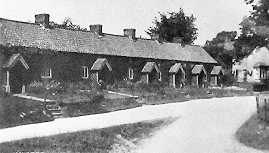
|
From Barrack Row to Thatched Cottages. The terrace was heightened and thatched by the Vestey family soon after they bought the estate in 1929. It is one of the most photographed views in East Yorkshire. |
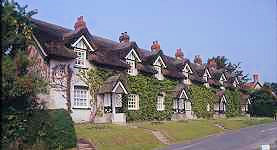
|
Three village households in 1901
Census returns for houses in the centre of the village 1901. This page contains the returns for five households including Manor House Farm, the Post Office and the wheelwright's, now half of Timbertops. You have seen pictures of all these houses on the previous pages.
Transcriptions of these three entries are given below. You can click here for a pdf version of the census returns to print out and use to answer the questions. When you have finished, click the BACK button on your browser to return here.
Key to headings of columns in transcription:
1 - Relation to Head of Family 2 - Condition as to Marriage - M = married S=single
3 and 4 Age last Birthday of Males (3) and Females (4) 5 - Employer, Worker or Own Account
6 - If working at home. The place of birth in last column is in the East Riding of Yorkshire unless stated.
House |
Name/Surname |
1 |
2 |
3 |
4 |
Occupation |
5 |
6 |
Where born |
Manor House |
John Byass |
head |
M |
37 |
|
Farmer |
employer |
|
North Dalton |
|
Mary E. Byass |
wife |
M |
|
37 |
|
|
|
Wetwang |
|
William H. Byass |
son |
S |
11 |
|
|
|
|
Wetwang |
|
Percival J. Byass |
son |
S |
9 |
|
|
|
|
Wetwang |
|
Mary Chapman |
servt |
S |
|
19 |
General servant |
worker |
|
Melbourne |
|
George Butler |
servt |
S |
22 |
|
Foreman on farm |
worker |
|
Chesterton,
Oxfordshire |
|
Robert Bell |
servt |
S |
20 |
|
Waggoner on farm |
worker |
|
Pocklington |
|
Alfred Smith |
servt |
S |
16 |
|
Waggoner on farm |
worker |
|
Allerthorpe |
|
Richard Craven |
servt |
S |
23 |
|
Shepherd on farm |
worker |
|
Pocklington |
Post Office |
Alfred Ottley |
head |
M |
45 |
|
Postmaster, Saddler and Grocer |
own account |
|
Bridlington |
|
Letitia Ottley |
wife |
M |
|
53 |
|
|
|
North Dalton |
|
Sarah M Wharram |
step-daur |
S |
|
28 |
Postmaster's Assistant |
worker |
at home |
North Dalton |
|
Florence A Ottley |
daur |
S |
|
17 |
Scholar |
|
|
Warter |
|
Mabel L Ottley |
daur |
S |
|
12 |
Scholar |
|
|
Warter |
|
Wilfrid B.Ottley |
son |
S |
10 |
|
Scholar |
|
|
Warter |
[Now Timbertops] |
James Craven |
head |
M |
43 |
|
Joiner and Wheelwright |
own account |
at home |
Huggate |
|
Jane Craven |
wife |
M |
|
41 |
|
|
|
Huggate |
|
Robert Craven |
son |
S |
18 |
|
Joiner/Wheelwright |
worker |
home |
Huggate |
|
Harriet Craven |
daur |
S |
|
15 |
|
|
|
Warter |
|
Harry Craven |
son |
S |
13 |
|
|
|
|
Warter |
|
Florence Craven |
dau |
S |
|
10 |
|
|
|
Warter |
|
James Craven |
son |
S |
7 |
|
|
|
|
Warter |
|
Mabel Craven |
daur |
S |
|
5 |
|
|
|
Warter |
|
Arthur Craven |
son |
S |
2 |
|
|
|
|
Warter |

|
Compare these households with that at Warter Priory and that in your own home. |

|
Consider the places of birth and the size of the families. What do the places of birth tell us about how far people moved in the past? |

|
From what you have learnt about the village in 1901 write a short story based on a day in the life of one of the children listed above. Use information from other Units. |
The contents of a Victorian labourer's cottage
Little is known about the possessions of ordinary people in the 19th century. Fortunately when Thomas Cook, an agricultural labourer, aged 74, from Warter, made his will in March 1870 he listed what must have been the total contents of his cottage.
He left his 'dear wife Elizabeth Cook the following articles of household furniture which belonged to her at the time of our marriage':
| One bed, bolster and pillow |
Two pairs of blankets |
| Three pairs of sheets |
Two quilts |
| Three pairs of pillowcases |
Six silver tea spoons |
| One pair of sugar tongs |
Four common meat spoons |
| One pair of drawers fir [pine] |
One pair of bellows |
| One looking glass |
|
To his children, Henry Cook of Warter, tailor, William Cook of Warter, agricultural labourer, John Cook of Grimsby, tailor, George Cook of York, shoemaker, and Ann wife of William Green of Stockton-on-Tees he gave the proceeds from the sale of:
| One four post mahogany bed stead |
One pair of mahogany drawers |
| One mahogany dressing table |
One washing stand |
| One close stool |
One warming pan |
| Two feather beds |
Two bolsters |
| Two pair of pillows |
One pair of blankets |
| Three pairs of sheets |
Two quilts |
| One corner cupboard |
One set of china |
| Six kitchen chairs |
One kitchen table |
| One clock (8 days) |
One small tea table |
| One stool |
One squab |
| Two brass candlesticks |
Two iron candlesticks |
| Two brass pans small |
One fish kettle |
| One copper kettle |
Two tin pans |
| One churn |
One milk strainer |
| Six milk bowls earthenware |
Six deep bowls or pankins earthenware |
| One meal tub |
Three water tubs |
| One oven range and grate |
Two fenders |
| One set of fire irons |
One wheel barrow |
| Two iron rakes |
One shovel |
| One dig |
One gavelock |
| Two spades |
Two hatchets |
| Two bills |
One slash knife |
| One pair of mittens, leather |
One hand saw, small |
| One manure fork |
One potato fork |
| Two rakes, wood |
Two bee hives and four stones of bacon. |
| He gave his silver watch to his son Henry. |
Thomas Cook could not write and signed his will with a X
[The vicar of Warter, the Revd Samuel Wilson, copied this will into his Memorandum Book.]
This well-furnished labourer's cottage contrasts with the brickyard cottage at Seaton Ross described above.

|
Reconstruct Thomas Cook's cottage. How many rooms do you think there were in Thomas Cook's cottage and what were they used for? |

|
Sort out the items listed above to their right location in the cottage, garden or outbuildings. |

|
Collect together some of the old-fashioned objects for a display, or illustrations of the objects. |
Village housing - continued from previous page
(for plan of Warter c. 1910 see Plan 5)

|
Carry out a survey of a selection of buildings in your village using a survey form. |
We have a suggested survey form. You will find it below. You can also print out a pdf version by clicking here. When you have finished printing it out, you can click the BACK button on your browser to return to this page.
Suggested survey form:
Village:
Name of person carrying out survey and date:
1. Name and location of house or building: Name/Number and Street
2. Drawing/photograph of building - indicate main features as below.
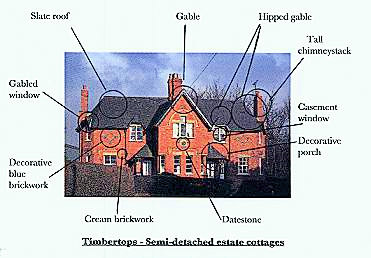
3. Is the house detached? semi-detached? or in a terrace [a row of three or more houses]?
4. Building materials:
Roof -
Thatch
Slate
Flat tile
Pantile
Walls -
Stone
Brick - colour of brick.
Rendered
5. Roof shape:
Gabled or Hipped
6. No of chinmeystacks:
7. No of windows at front of house?
Type of windows: Casement/Sash Wooden/Plastic
8. Is there a porch?
9. Is there a datestone? What date? Is there also a name or initials?
The Landowner and the villager
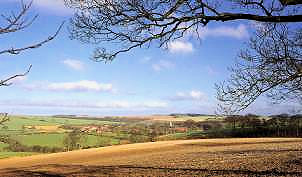
The estate village of Warter, East Riding of Yorkshire
 A century ago the whole parish of Warter and all the houses in the village were owned by Charles Wilson, later Lord Nunburnholme A century ago the whole parish of Warter and all the houses in the village were owned by Charles Wilson, later Lord Nunburnholme
In the past if you owned the whole of a village then you had great power over the lives of the villagers.
Many landowners used their power both to control the villagers and to care for them.
It was the opinion of the Duke of Bedford in 1850 that it was the duty and ‘ought to be amongst the truest pleasures of every landlord' to:
Improve the dwellings of the labouring class, and afford them the means of greater cleanliness, health, and comfort in their own homes; to extend education, and thus raise the social and moral habits of those most valuable members of the community.
The Duke acknowledged that there were ‘undeniable advantages of making the rural population content with their condition'.

|
Activities : In this Unit the various ways that the Muncaster and Wilson families cared for and controlled the lives of the villagers at Warter are described. At the end of the Unit you will be asked to list the advantages and disadvantages of living in an estate village and to decide whether or not you would have liked to have lived in an estate village, such as Warter, a century ago. |
The Muncasters and Wilsons rebuilt the village houses
 In 1865 Warter was described as ‘an extraordinarily shabby village'. The cottages were covered with ‘mossy, mouldy thatch' and they had ‘bulging walls, uneven floors, windows that will not open and doors that will not shut'. The occupants slept ‘in windowless, chimneyless lofts'. In 1865 Warter was described as ‘an extraordinarily shabby village'. The cottages were covered with ‘mossy, mouldy thatch' and they had ‘bulging walls, uneven floors, windows that will not open and doors that will not shut'. The occupants slept ‘in windowless, chimneyless lofts'.
By 1900 Warter had been rebuilt and the villagers lived in handsome two-storey brick houses with slate roofs, many having three bedrooms and all having a large garden.
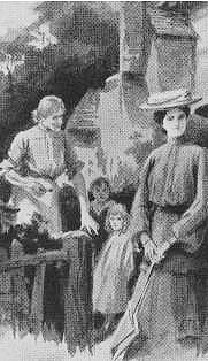 The Wilsons provided free housing for the elderly. Some were accommodated in the terrace by the village green and others were allowed to remain in their old homes. In January 1905 the Pocklington Weekly News reported that: The Wilsons provided free housing for the elderly. Some were accommodated in the terrace by the village green and others were allowed to remain in their old homes. In January 1905 the Pocklington Weekly News reported that:
Mr. C.H. Wilson, M.P. is a real good sort. Another instance of his generosity has just come to our
notice. He has just recently told two aged tenants that they are not to pay any more rent - but are to live rent free for the remainder of their lives. Bravo, Mr Wilson.
BUT
• When an employee was sacked he and his family lost their home.
AND
• Mrs Wilson (later Lady Nunburnholme) had the habit of driving round the estate in her carriage, stopping at any of the cottages and throwing open the door without knocking. She was extremely critical if she detected any evidence of careless housekeeping.
The landowner built and maintained the village school
 • Lord Muncaster built a village school in 1868 and he and his successors took a great interest in promoting the education of the village children. • Lord Muncaster built a village school in 1868 and he and his successors took a great interest in promoting the education of the village children.
• The schoolchildren were given a Christmas treat at the Priory and holidays were granted for Wilson family weddings, cricket matches and other events at the big house.
 BUT BUT
- The landowner hired and fired the teachers.
- He and his family made unannounced visits to the school, and sometimes interfered with the work of the teachers.
- Girl pupils were made to hem sheets for Mrs Wilson at Warter Priory.
- Boys were taken from the school to ‘bushbeat' when the family at the big house had a shooting party.
The landowner supported village organisations that promoted saving.
WARTER CLOTHING CLUB. The annual breakfast in connection with this Club was held on Tuesday morning at the Odd-Fellows' Arms, Pocklington when 40 members partook of an excellent repast, provided by Mr Jarvis, the landlord. The club is open to the villagers of Warter, and whatever amount is paid during the year in subscriptions, 25 per cent is generously added, together with a free breakfast, by Mr and Mrs Wilson, of Warter Priory, who take great interest in the club. The money subscribed is to be spent in necessary winter clothing, amongst the shopkeepers of Pocklington. - Pocklington Weekly News 9 November 1895
The landowner rebuilt the village church
The dilapidated village church was rebuilt by the Muncaster family in 1862-3. Soon after work had begun on the new church, Lord Muncaster died of fever near Naples in southern Italy, aged 30, and the building was completed in his memory by his brother and successor, Josslyn Frances Pennington, 5th Lord Muncaster.
  The moving memorial to Lady Isabel Wilson, daughter-in-law of Lord and Lady Nunburnholme, who died at the age of 26 in 1905. Now in the church the monument was originally placed in a huge mausoleum (demolished 1966), that was added to the north side of the church. The moving memorial to Lady Isabel Wilson, daughter-in-law of Lord and Lady Nunburnholme, who died at the age of 26 in 1905. Now in the church the monument was originally placed in a huge mausoleum (demolished 1966), that was added to the north side of the church.
 Stained glass (right) commemorating Gerald Wilson, youngest son of Lord and Lady Nunburnholme, who died in mysterious circumstances in Paris in 1908, at the age of 23. Stained glass (right) commemorating Gerald Wilson, youngest son of Lord and Lady Nunburnholme, who died in mysterious circumstances in Paris in 1908, at the age of 23.
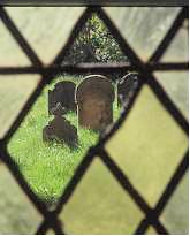
Warter Churchyard (left)
- The church is filled with superb stained glass and monuments to the Muncaster and Wilson families; the villagers are commemorated by gravestones in the large churchyard.
- The Wilsons were great benefactors to the church and provided all the fittings and a fine organ.
- The landowner and his family sat in grand seats with comfortable cushions in the front row of the nave.
BUT
The majority of the villagers were Methodists and they preferred to attend their own chapel.
The landowner and the estate provided work for everyone in the village
Everyone in Warter village was dependent on the landowner in one way or another for their homes and employment although less than a quarter of the workforce worked directly for the estate. Trade directories and census returns provide information on the occupations of villagers in the 19th and 20th centuries. [Click here for the 1901 trade directory entry for Warter.] Trade directories do not list every worker in the village, only the employers - the gentlemen, professionals, farmers, and tradesmen. For a fuller account of the village workers you have to look at census returns.
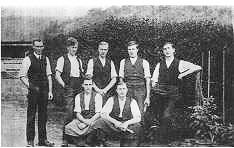
|
Head Gardener and assistants, c.1900 |
There were about 25 indoor staff at Warter Prioryand 40 outdoor staff, including gamekeepers, gardeners, woodmen and grooms in the stables. [Click here for Census enumerators' returns for laundry, stables and garden staff in 1901.]
Some 60 per cent of those in employment at Warter in 1901 worked on one or other of the 14 farms on the estate. The greater part of the workforce (84 males and 20 females) was made up of young men and women hired by the year who lived-in on the farms. Nearly all lived with the tenant farmer and his family. [Click here for Census returns for Blanch Farm.]
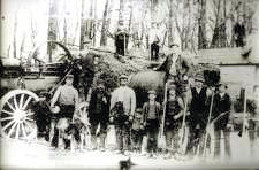

|
Workers on a Yorkshire Wolds farm at threshing time. How many men and boys can you see? How many are wearing hats or caps? |
Unlike many rural villages in 1901 there was no unemployment at Warter, and the population was not declining, thanks to the jobs on the estate.
BUT
There was no job security and you could be sacked on the whim of the employer, and lose both work and home. Billy Harrison, who started work in the gardens at Warter Priory in 1912, recalled that: One day a gardener appeared with a neatly sewn patch on his breeches. "I don't allow men to work in clothes like that" her ladyship told him. "You're dismissed".
As the vicar of Warter reported in 1894 the greatest hindrance to his work in the village was: ‘The uncertain action of the wife of the landlord of whom the people are in much dread'.
Four examples follow of ways that the Muncasters and the Wilsons (later Lords Nunburnholme) controlled the lives of the villagers at Warter.
* No Railway *

The coming of the railway was one of the greatest changes that towns and villages experienced in the Victorian period. When plans were being made for building a railway line from York to Beverley via Market Weighton the tenant farmers at Warter petitioned the company asking that the line be built through Warter parish and that a station be built there. However when the railway company surveyor arrived at Warter on 6 October 1845 and began work on planning the route of the railway line he was issued with the following by each of tenants along the proposed route:
I do hereby give you Notice that if you trespass upon the land now in my Occupation situate in the parish of Warter in the East Riding … An Action at Law will forthwith be Commenced against you for such trespass.
Lady Muncaster, then running the estate for her fourteen-year old son who had inherited on the death of his father in 1838, was against any railway line being built across her land. She had ordered all the tenant farmers to issue notices with this wording.
No railway was built through Warter parish and the villagers had to travel over 3½ miles (6 kilometres) to the station at Burnby. [The name of this station was changed to Nunburnholme because it had been confused with Burnley in Lancashire.]

|
List the reasons why you think Lady Muncaster would have objected to a railway through Warter. |

|
Why did the tenant farmers want a railway station at Warter? |

|
Re-enact the scene when tenant farmers presented their notices to the surveyor. |

|
Look at a map and trace the route that a railway line might have taken from York, through Warter to Market Weighton. Find Burnby village. The station was between the villages of Burnby and Hayton. |

|
In what ways would the village of Water be affected by not having a station? |
* No Chapel *
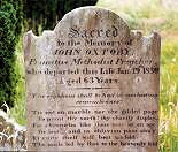 In the churchyard at Warter there is a gravestone to the memory of John Oxtoby, Primitive Methodist Preacher, who died in 1830 aged 63. John Oxtoby 'Praying Johnny' was one of the heroes of the early Primitive Methodist church. The Primitive Methodists (nicknamed 'The Ranters') were a Christian group who by enthusiastic preaching, open air meetings and the involvement of ordinary people in taking services and running of their chapels, attracted a great following amongst the farm labourers of eastern England, the urban poor and the inhabitants of the new coal mining villages. Primitive Methodism was introduced into the East Riding in 1819. In the churchyard at Warter there is a gravestone to the memory of John Oxtoby, Primitive Methodist Preacher, who died in 1830 aged 63. John Oxtoby 'Praying Johnny' was one of the heroes of the early Primitive Methodist church. The Primitive Methodists (nicknamed 'The Ranters') were a Christian group who by enthusiastic preaching, open air meetings and the involvement of ordinary people in taking services and running of their chapels, attracted a great following amongst the farm labourers of eastern England, the urban poor and the inhabitants of the new coal mining villages. Primitive Methodism was introduced into the East Riding in 1819.
Thanks to Johnny Oxtoby there was soon a group of Primitive Methodists at Warter. At first they met in each other's houses but they wanted to build themselves a chapel. The older established Wesleyan Methodist s had built a chapel at Warter in 1808, but in 1863, after 40 years in the village, the Primitive Methodists recorded that they still had no meeting place.

|
The former Wesleyan Methodist chapel, which was greatly extended in 1878. It was closed in 1974 and converted to a private house. |
We have at present an interesting society of twenty members. We have however never been able to obtain a piece of land for a chapel; and have been subjected to painful annoyances. For instance, only last missionary anniversary we got a farmer to promise to allow us to hold our meeting in his barn; and after we had gotten the bills published, and the barn ready for the meeting the steward [of Lord Muncaster] sent instruction to the farmer that we were not to have it, and we could obtain neither barn, joiner's shop, blacksmith shop, nor any place larger than a small cottage… All the land except two small pieces measuring about half-acre each, belongs to Lord Muncaster. His Lordship has been applied to again and again and either could not or would not sell or lease us a piece. There is, therefore, only the two pieces named. On one of those the Wesleyan Chapel and some cottages stand, hence we are shut up to the other small piece…
After some years the Primitive Methodists managed to obtain a small plot and by 1892 had built a modest chapel. It closed in the 1930s and has since been demolished.
 |
Why did Lord Muncaster want to stop the Primitive Methodists from meeting at Warter? |

|
Was he right to prevent them building a chapel? |

|
Find out about the Methodist Church.
https://www.methodist.org.uk/ |
* No Pub *
There is no public house at Warter, or at the nearby villages of Nunburnholme and Londesborough. All three villages had pubs in the 18th and early 19th centuries. In the 1780s the public house at Nunburnholme was described in a letter from Sir John Pennington of Warter to the local magistrates as:
one of the most disorderly Houses in the Country … a large Gang of the most bold, daring, notorious Gamblers, Cockfighters, Wood stealers and poachers meet there continually … They have frequently Cockfights and Carding all Night, during which time some of the party go out, Shooting by Nights in the Snow and I hear the Guns all round My House..
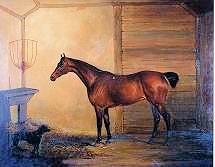
|
The racehorse Creeping Kate from a painting at Muncaster Castle |
The public house at Warter, known as 'The Creeping Kate' by the 1820s, stood on the site of the present Post Office. The signboard was said to depict a woman crawling on her hands and knees although the pub was named after a racehorse owned by the Penningtons.

|
Draw a picture of the signboard for 'The Creeping Kate' |
Not long after the Wilsons bought the Warter estate it is said that Mrs Wilson was being driven in her coach to church one Sunday when she 'saw some of the estate workers standing outside 'The Creeping Kate' … She asked the coachman what they were doing and he said they were waiting for the pub to open. "Disgraceful" said Mrs Wilson, and at once 'The Creeping Kate' was closed down for good.' This story told by Billy Harrison (1898-1986) may not be entirely accurate but there is no doubt that the Wilsons closed the village pub in 1882 with the intention of converting it to a temperance meeting place. George Noble attributed the action to Mr Wilson ' He didn't like a lot of drink. He said at the time that the working man could not afford it. He'd seen that much poverty in Hull.'

|
What were the Wilsons' objections to having a public house in the village? Other estate villages such as Sledmere and South Dalton still have pubs. |

|
Do you think the closing of the pub was justified? Write letters for and against the opening of a public house in the village today. |

|
Look at the extract from Sir John Pennington's letter. Would you put capital letters at the beginning of so many words? How would you write this letter? |
* No freedom? *
As we have seen, a hundred years ago the Wilson family of Warter Priory 'controlled' every aspect of the villagers' lives. In theory since the introduction of the secret ballot in 1872 those that had the right to vote had had the freedom to express independent views at national and local government elections. We do not know if they did but when the first parish council was elected in 1894 Charles Wilson was chosen as the first chairman.
Before 1872, when only a handful of male villagers had the right to vote, the way everyone had voted at parliamentary elections was public knowledge and was published in a poll book. In 1837 and 1868 poll books were printed after the election of two Members of Parliament to represent the East Riding of Yorkshire. At that time the Muncasters, who were Conservative supporters, owned Warter.
In 1837 the 10 voters from Warter gave their two votes to the two Conservative candidates, Richard Bethell of Rise and Henry Broadley of Sutton on Hull. No-one voted for the Whig (Liberal) candidate, Paul Beilby Thompson of Escrick Park. Not surprisingly the 20 voters from Escrick all voted solely for Thompson. Just over 30 years later in 1868 there were 18 who voted from Warter and once again they voted solidly for the Conservatives.

1868 Poll Book entry for Warter parish:
The candidates were S = Sykes, Conservative, B = Broadley, Conservative, H = Haworth, Liberal.
With the sale of the estate in 1878 Warter passed from a Conservative to a Liberal landlord. Even after secret voting was introduced East Riding landowners tried to dictate the way their tenants voted but it is probable that at the end of the 19th century many Warter tenants willingly followed the lead of their squire Charles Wilson who was Liberal M.P. for Hull. The villagers who were strongly Methodist were also likely to be Liberal in politics.
Further Activities
A . Using information from this and other units decide if you would have liked to have lived in an estate village in the Victorian period. |

|
Make lists of the good things and the bad things about living in an estate village. |

|
What are the differences between living in Warter now and 100 years ago? |
|
|
B. Conduct a mock election. Select two candidates, one in favour of living in the estate village and one not. The candidates with the help of their supporters will present their views and then the whole class will vote. Produce a class poll book detailing the result.
|
|
|
C. Activities involving trade directories and census enumerators' returns. |

|
a. Using the trade directory entry for Warter in 1901 add up the number of people listed under the various occupations.
How self sufficient was Warter in 1901? Would the villagers have to travel to get any goods or services? Could they have survived without ever leaving the village?
What things could they get in the village in 1901 that they cannot get now when there is only a small Post Office? |

|
b. Using the census enumerators' returns for the household at Warter Priory in 1891, and the laundry, stables and gardens in 1901 answer the following questions:
• It is usually said that in estate villages boys and girls found work at the big house or on the estate when they left the village school. From the birthplaces given for the workers at the house, stables and gardens was this the case at Warter?
• Using an atlas of the British Isles locate the places where the various workers in the house, stables and gardens were born? Draw a map linking their birthplaces with Warter and calculate how far they were from their birthplace. Who had travelled the furthest? Was there anyone born outside the British Isles?
• What was the average age of the female workers and the male workers? Who were the youngest workers and who were the oldest?
Also look at the birthplaces and ages of the farm workers at Blanch Farm. |
|
|
The Village School
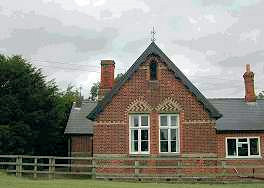
|
The old school |
The school at Warter, along with everything else, was owned by the Lords Muncaster and their successors. The landowner appointed the teachers and had a major say in how the school was run.
There was a village school at Warter by the early 19th century. It was held in a modest thatched building on the south-east corner of the village green.
A new village school and schoolmaster's house were built by Lord Muncaster in 1868.The school, consisting of two large rooms and a smaller class room, could hold 140 children.
The present school was built in 1975-6 and the 48 children then on the roll transferred there on 26 April 1976. The old school became the village hall.
In 1901 the teachers were Charles Cookson, headmaster, his wife Jane Cookson who was the infants' mistress, Fanny Smith, assistant mistress, and the Cooksons' daughter Eva who was a pupil teacher. The average attendance in 1901 was 85, of which 25 were infants.
The school log book kept by Charles Cookson from 1893 to 1904 survives and provides a wealth of information on both the school and village life.
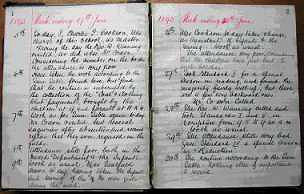

|
Activity 1 - The class, or individual pupils, to keep a log book recording the school events, including lessons, for one week. |
The school day began at 9 a.m., with a religious assembly, sometimes taken by the vicar. On 23 February 1894 Mr Cookson recorded in the log book:
This morning, the children, (instead of going to Church, as had originally been intended) stayed at School, and were addressed by the Rev. W. Winning on 'Our duties and obligations during Lent', from 9.5 to 9.35. The attendance has fallen off somewhat today.
The log book records regular lessons in the three 'Rs' - reading, writing and arithmetic with the master noting on one occasion that:

|
A boy writing on a slate |
Very many of the scholars in Standards II and II spell so very badly, that I have given them special Blackboard lessons today.
The use of the blackboard, probably a recent addition to the school equipment, is often mentioned. The children wrote on slates, although in October 1893 the master commented: Routine as usual, but instead of Slates, the children had paper.
 |
Activity 2. Obtain slates and practice writing on them. List the equipment now used by pupils and teachers in your school. |
 Once a week the older girls went into the infant room for sewing and knitting with Mrs Cookson, whilst the boys received lessons in drawing. Advantage was taken of the girls' sewing lessons by Mrs Wilson. In April 1895 the master 'Received from the Priory (by Mrs Wilson's orders) a parcel of material (sheets &c) for the girls to hem'. Once a week the older girls went into the infant room for sewing and knitting with Mrs Cookson, whilst the boys received lessons in drawing. Advantage was taken of the girls' sewing lessons by Mrs Wilson. In April 1895 the master 'Received from the Priory (by Mrs Wilson's orders) a parcel of material (sheets &c) for the girls to hem'.

 |
Activity 3. How many children in your class can sew (boys and girls)? Give reasons for and against sewing lessons. |
Most of the lessons were very formal with the whole class being taught together. A great deal of time was spent in preparing for the annual visit of Her Majesty's Inspector of Schools. Much had to be learnt by heart and then sung or recited in front of the inspector, who would question the pupils. In 1894 Mr Cookson  recorded that amongst the songs prepared for the inspector's visit were: Merry Christmas Bells, Hearts of Oak and Whistling Farmer Boy by the older scholars and Babyland, Marching Song and Sing a Song of Sixpence by the infants. The older pupils learnt for recitation 'Edinburgh after Flodden', 'The recorded that amongst the songs prepared for the inspector's visit were: Merry Christmas Bells, Hearts of Oak and Whistling Farmer Boy by the older scholars and Babyland, Marching Song and Sing a Song of Sixpence by the infants. The older pupils learnt for recitation 'Edinburgh after Flodden', 'The Shipbuilders', 'The Beggar Man', and 'The Fox and the Grapes' and the infants prepared 'Family Cares', 'The Lost Kitten', 'Falling Snow' and 'No Wings'. Shipbuilders', 'The Beggar Man', and 'The Fox and the Grapes' and the infants prepared 'Family Cares', 'The Lost Kitten', 'Falling Snow' and 'No Wings'.
Object lessons were given to the infants on The Clock, The Horse, The Sheep, Harvest, The Cow, Bread, Boots and Shoes, Birds' Nests, Good Manners, The Seal, The Cat, The Pig, The Goat, Poultry, Form and Colour, Setting a Tea Table, Cleanliness. The Object Lessons were often illustrated by posters and there was some attempt to relate them to topics familiar to the country children.
 |
Activity 4
Re-enact the visit of Her Majesty's Inspector. Select a poem or a piece from a favourite book and learn it by heart so that you can recite it to the whole class. Think up questions that might be asked by the inspector about birds' nests, the cow, good manners and cleanliness. What answers would you give? |
Poor attendance was a constant problem for the master. Occasionally it could not be helped, due to sickness and bad weather:
23 October 1894 Mrs Cookson called my attention to the excessive number of absentees from the Infant Room, which upon enquiry, was found to be the result of whooping cough.
31 Dec 1894 The attendance has been very poor today, in consequence of the excessive stormy weather. Snow 4ft deep.
2 January 1895 The children from a distance are quite unable to reach school.
4 November 1895 Many of the children are still away with 'colds'. Replies to enquiries show that parents are afraid of Diptheria which has been very bad at the eastern end of the village.
29 June 1900 There are several cases of Scarlatina and Scarlet Fever in the parish.
1 January 1901 School re-opened after being closed 8 weeks on account of prevalence of Scarlet Fever and Measles.
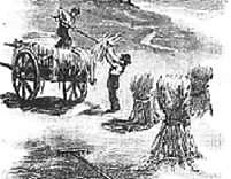 Many older children were frequently absent 'working in the fields' with their parents' permission: Many older children were frequently absent 'working in the fields' with their parents' permission:
1 July 1894 The attendance very poor. Weather bad. Sent to make enquiries about absentees; most of the replies were 'singling turnips'.
10 June 1895 Today many of the older children are away pulling 'ketlocks'. I, some days ago, sent out a circular calling the attention of parents to the 'Act for the regulation of the employment of children in labour', but it seems to have had no effect.
27 August 1895 I find that many of the children are working in the harvest fields.
23 June 1898 This morning there were 46 scholars present in the upper room, and 22 absent, nearly all of the latter being on the farms 'Ketlocking'.
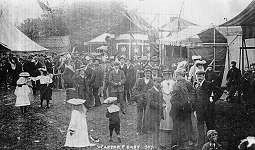
|
Warter Feast 1907 |
Then there were the absences for the various village events which always appear to have been held on a weekday. For some a holiday was given.
1 August 1893 Holiday all day on account of the Flower Show.
8 August 1893 Today many of the children are away on account of a Trip [Wesleyan Methodist Chapel Sunday School] to Bridlington of which the majority of the parents seem to have availed themselves. Otherwise the work has been as usual.
9 August 1893 Holiday all day on account of the Choir Trip.
7 November 1894 Several children away on account of 'Clothing and Coal Club'.
18 June 1896 Preparations for the feast are being made in Mr Otley's field.
19 June 1896 This being 'Warter Feast Day' the children had their usual holiday.
16 June 1898 In the afternoon the attendance was very poor, many of the children, with their parents' consent being in the 'Feast Field' watching the preparations for to-morrow.
Unit 4: The Village School
In an estate village the distractions were plentiful, especially when the Wilson family were resident at Warter Priory:
4 August 1893 Holiday in the afternoon on account of the children going to the Priory to watch the Cricket Match
7 August 1903 On Thursday afternoon, the children had half holiday, in consequence of the Garden Fete in the Priory grounds.
The older boys were usually absent when there was a shooting party at the 'big house'.
22 January 1894 Ed. Hall & Tom Witty called for by one of the gamekeepers to bushbeat for Mr Wilson & party.
17 October 1894 Several of the boys away bushbeating for the Shooters.
13 February 1895 The attendance today has not been quite so good as usual; several of the boys having run off in the afternoon after the shooters.
27 November 1895 The attendance very poor today. Many of the children being absent 'bushbeating' & watching the shooting.
The interest taken by the Wilsons in the school could also have its benefits:
|
27 December 1897 During the afternoon Mrs Wilson called at the School and ordered the scholars to have holiday for the remainder of the week [4 days] as the school had to be got ready for a School Treat and large Christmas Tree, which she desired to give on Thursday 30th. |

|
Activity 5: List the reasons given a hundred years ago for children missing school. Which reasons should have been allowed and which not and why? |

|
What reasons are given for children missing school today? Are any the same as a hundred years ago? |

|
Which illnesses are the most common causes of absence today? Why should you try not to miss a single day at school? What was the same and what was different about school now and a hundred years ago? |
School Photograph
One of the highlights of the school year was the visit of the photographer as Mr Cookson noted in the log book, 16 July 1895. Immediately before the beginning of the afternoon session the whole of the children were photographed in two groups.
We have not found any pictures taken in 1895 but here are two taken at Warter by a visiting photographer in July 1913 and one taken at Sledmere school in February 1889 by the master to celebrate the fact that no child was absent.
|
Above: Photograph A, Warter School, 25 July 1913 |
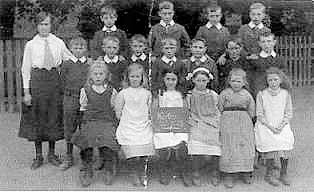
|
Above: Photograph B, Warter School, 25 July 1913 |
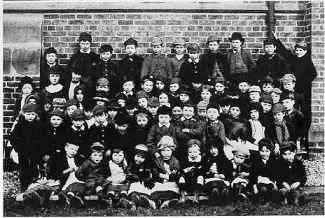
|
Above: Photograph C, Sledmere School, February 1889 |
Activity 6: Worksheet. Click here for a pdf version you can print out to answer the questions. Use the BACK button on your browser to return here when you have printed out the sheet.
1. Look at photographs A and B
a) Someone appears on both photographs. Who do you think it is?
b) How many boys and how many girls are in photographs A and B? How does the proportion of girls to boys in the classes in 1913 compare with the proportion in your class today?
c) What age do you think the children are in the photographs?
d) Are the boys in photograph A old enough to have fought in World War I or World War II?
2. Compare photographs A and B with photograph C.
a) In what ways are the children's clothes in A and B different to those you wear to school?
b) Do you think they are the clothes the children usually wore to school? If not why not?
c) What are the major differences between the clothes worn by the Sledmere pupils and the clothes worn at Warter?
d) What reasons can you suggest for the differences in clothing between the Sledmere and Warter pupils?
e) How many boys and how many girls are in photograph C?
|

